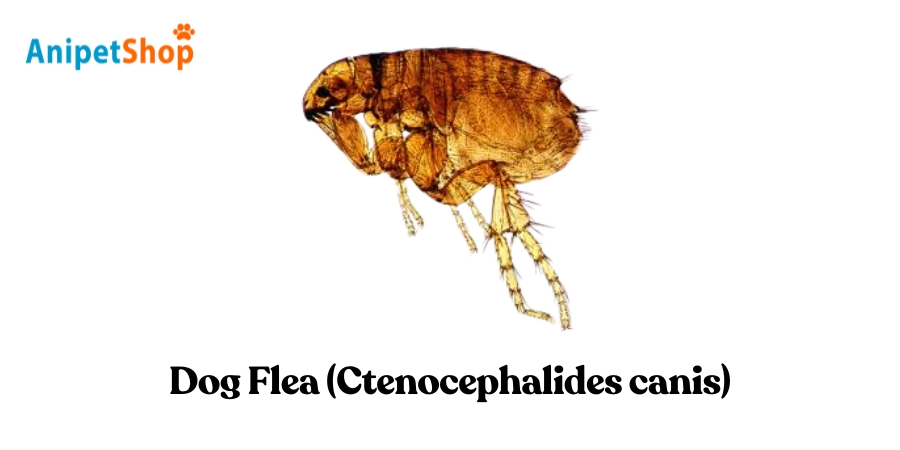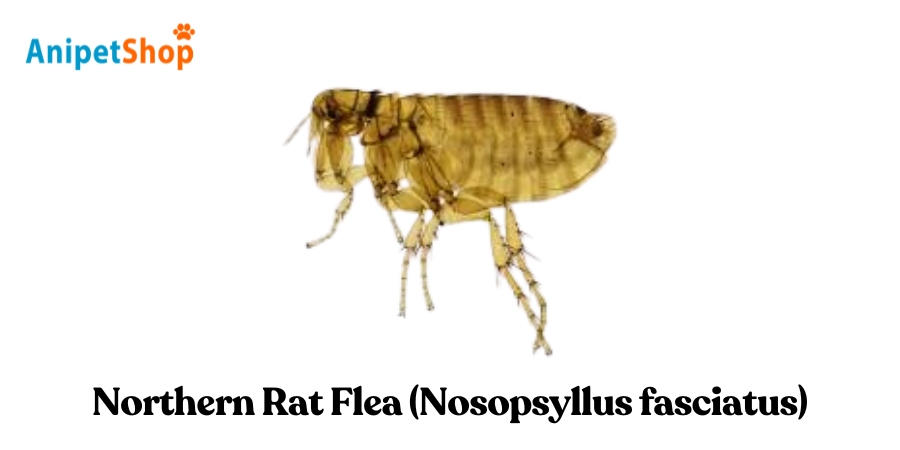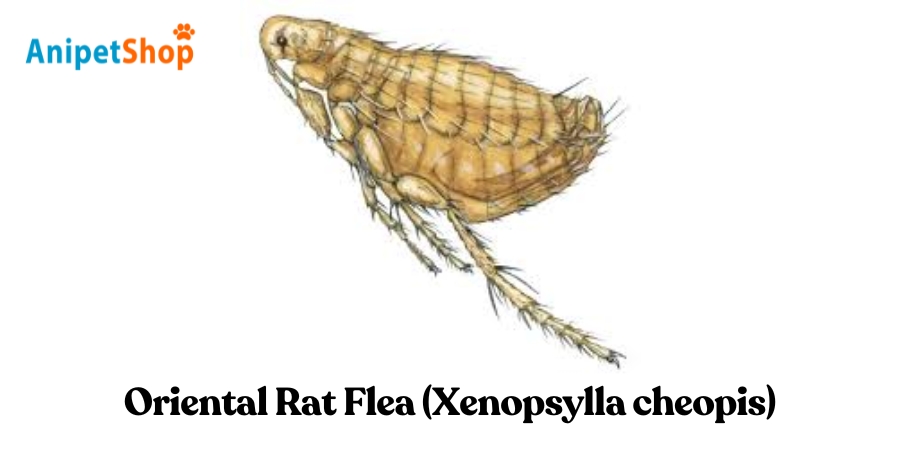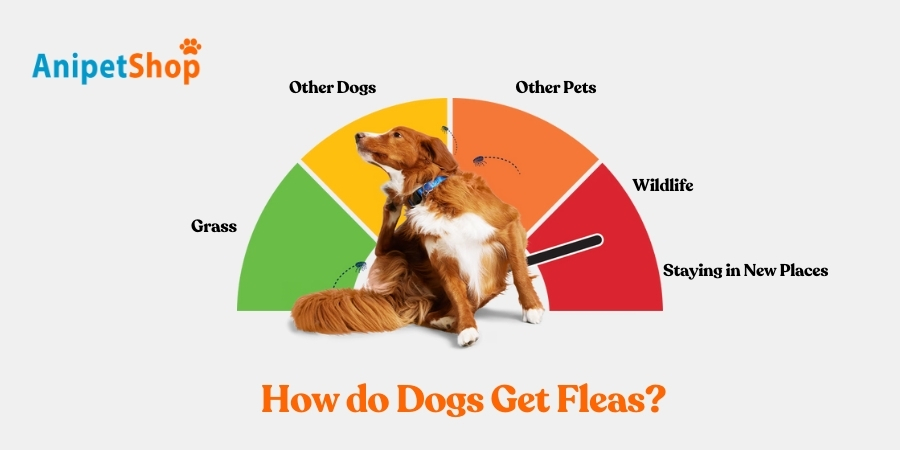Fleas on Dogs: What You Need to Know
Dog fleas, known scientifically as Ctenocephalides canis, are tiny, reddish-brown, wingless insects approximately 1-4mm long. These pests have oval-shaped bodies and are equipped with strong legs for jumping. To identify if your dog has fleas, inspect for signs such as itching, redness, and flea dirt. Effective removal includes using a flea comb, specialized flea shampoos, and vet-approved topical or oral treatments. Regularly washing your dog’s bedding and vacuuming your home can also help. For a detailed approach to maintaining a flea-free environment for your dog, there’s more useful information ahead.

What are dog fleas?
Dog fleas (Ctenocephalides canis) are common parasites that infest dogs and rabbits. These tiny pests are brownish-black, about 1-4 millimeters long, and have bodies flattened sideways, allowing them to navigate through their hosts’ fur easily. Although they lack wings, their powerful hind legs enable them to jump great distances. Their claws help them cling tightly to their hosts, and their specialized mouthparts are designed for piercing skin and sucking blood.
Fleas cause significant discomfort and irritation through their bites and can transmit various diseases, making their control and eradication crucial for pet health. These parasites are a widespread concern, particularly in the United States and globally.
Physical Characteristics:
- Color: Brownish-black, appearing reddish-black when engorged with blood.
- Size: 1/8” (Approximately 1-4 millimeters).
- Legs: 6.
- Antennae: Yes.
- Shape: Flat.
- Region: Found throughout the United States.

What are the stages of a flea’s life cycle?
Fleas undergo four distinct life stages: egg, larva, pupa (within a cocoon), and adult. The duration of their life cycle varies widely depending on environmental conditions such as temperature and humidity, which can accelerate or slow down each stage. While an adult flea lives on its host for only a few weeks, it begins reproducing within days, leading to rapid population growth. Under ideal conditions, a flea can complete its life cycle—from egg to adult—in about a month. However, unfavorable environmental factors can extend this period to a year or more, allowing dormant fleas to remain viable and emerge later.
The flea life cycle includes four main stages:
- Egg: After a blood meal, female fleas lay eggs on the dog’s skin or fur. These tiny, light-colored eggs quickly fall off into the surrounding environment, where they hatch in two days to two weeks.
- Larva: Upon hatching, larvae are just a few millimeters long, resembling tiny worms. They feed on organic matter as they mature through several stages. The final stage produces a protective sticky cocoon, called a pupa.
- Pupa: This stage is particularly resilient, as the sticky cocoon attracts dust and debris for camouflage. Inside, a flea can develop into an adult in as little as 10 days but may remain dormant for 6–12 months depending on conditions. These pupae are often buried deep within carpets or beneath organic debris, making them difficult to detect and remove.
- Adult: The adult flea emerges from the pupa in response to cues like warmth, vibrations, or increased carbon dioxide. Within minutes of finding a host, newly emerged fleas begin feeding and can start producing eggs within a day or two.
The pupal stage is one of the main challenges in flea control, as dormant pupae can lie undisturbed for months. This resilience means that fleas may suddenly appear in an environment that has been clean and free from infestation, leading to a rapid resurgence. Proper flea control focuses on interrupting this lifecycle at each stage, reducing the likelihood of new generations appearing.
How long does a flea’s life cycle take?
Dog fleas can live for about 100 days, during which time the females produce 400-500 offspring. Their biology and habits are the same as cat fleas. Dog flea eggs are deposited on dogs in between their hair. They usually hatch in 1-12 days. The larvae require feeding on dried adult fecal blood to complete development. Dog flea larvae spin cocoons and emerge after several weeks, usually when the temperature increases, or vibrations force them out. Adults seek a blood meal on the second day after emergence. Once a dog flea finds a host, it will feed, mate and lay eggs on it.
Depending on conditions, adult dog fleas usually only live for a few days, because normal dog grooming removes up to 50 percent or more of the fleas. Otherwise, they can survive for several months.
Different Types of Fleas You Can Find on Dogs
Fleas are a common issue for pet owners, with over 2,000 species identified globally and approximately 300 residing in the United States. Among these, the most frequent intruder in homes and on pets is the cat flea, Ctenocephalides felis. While cat fleas are typically responsible for infestations on dogs, other flea species occasionally appear. Below are the most common types of fleas that might affect your dog:
Cat Flea (Ctenocephalides felis)
The cat flea is the most common flea species found on domestic animals, including both cats and dogs. It has a reddish-brown, flattened body that allows it to move easily through pet fur. Known for its resilience, the cat flea can thrive indoors and outdoors and is responsible for most flea infestations on pets in the United States.

Dog Flea (Ctenocephalides canis)
The dog flea is similar in appearance to the cat flea but is less common in North America. It has a rounded body adapted for moving through thick dog fur. Although not as prevalent as cat fleas, dog fleas can also infest both dogs and cats, leading to itching and discomfort if untreated.

Northern Rat Flea (Nosopsyllus fasciatus)
This flea species is typically found on rats and other small rodents rather than household pets. The Northern Rat Flea is slightly larger than the common cat and dog fleas and is primarily known for its role in transmitting diseases among rodents. Though rare in domestic environments, it can occasionally be encountered in areas with high rodent populations.

Oriental Rat Flea (Xenopsylla cheopis)
Often associated with rats, the Oriental Rat Flea is well-known historically as a vector of the plague. It prefers rodents as hosts but can bite other mammals, including pets and humans, if rodents are unavailable. This flea species has a sleek, flattened body that enables it to navigate dense fur.

Rabbit Flea (Cediopsylla simplex)
The rabbit flea is primarily found on rabbits and occasionally on other wildlife. It is distinguishable by its longer legs, which aid in hopping from host to host. Though rarely a household pest, it may be seen on dogs if they come into contact with wild rabbits or their habitats.

Where Do Fleas Come From, Hide, and Thrive?
Fleas are small, stealthy pests that often enter homes by latching onto animals or outdoor vegetation during different stages of their lifecycle. Commonly, they’re brought indoors when pets pick them up outside, but they can also attach to shoes, clothing, or other items left outdoors, eventually making their way inside.
Although fleas don’t live on humans, they can bite and leave itchy welts. They’re also adept at hiding in a home’s secluded areas—even in pet-free environments. To prevent an infestation, it’s essential to take proactive steps in treating your yard. Understanding where fleas commonly live, breed, and thrive outdoors can help you keep them from ever becoming a problem indoors.
Where Do Fleas Live Outside?
Fleas thrive in warm, humid outdoor environments, often hiding in tall grass, shrubs, and shaded areas near trees. They’re drawn to damp, concealed places, making grassy spots and leaf litter ideal for their early life stages. Commonly, they latch onto urban wildlife such as raccoons, foxes, or squirrels, which often visit residential areas. Your pet may unknowingly pick up fleas from areas frequented by these animals, like kennels or favorite spots on the porch.
During their lifecycle, fleas spend most of their time detached from hosts, moving through egg, larval, and pupal stages hidden in damp, shaded areas. Only as adults do they need a warm-blooded host to survive long-term. This lifecycle allows fleas to re-enter homes, even if pets have been treated.
Where Do Fleas Live Inside the House?
Indoors, fleas seek out textured surfaces like carpets, bedding, upholstery, and clothing as ideal hiding spots. Flea larvae, in particular, burrow into dark, protected areas, while eggs may settle into these same spaces. Fleas can also temporarily hide in concealed spots such as crevices under baseboards or in the flooring of pet crates.
Fleas breed primarily on the skin and fur of their host, laying eggs directly on the animal. They also target areas frequented by pets, such as dog beds, where eggs can easily drop off and continue developing in the home environment.
Where Are Fleas Found on a Host?
Adult fleas often settle on the back, neck, abdomen, and under-limb areas of cats and dogs, where they can avoid being scratched or bitten off by the pet. These parasites nestle into smaller crevices, such as joints, making them more challenging for pets to reach. Flea eggs, larvae, and pupae, however, generally live off the host in nearby areas like bedding or carpeting.
If your pet exhibits signs such as constant scratching, biting, fur loss, or red, itchy bumps on the skin, fleas may be present. Adult fleas can survive for up to three months without feeding on a host. They eventually need a warm-blooded host to survive and reproduce. Animals with thick or long fur are the best hosts for fleas, giving them something to nestle into easily.
How do Dogs Get Fleas?
Dogs can get fleas in several ways, often through direct contact with infested animals or environments. When dogs play or interact with other flea-infested dogs during walks, at dog parks, or during playdates, fleas can easily transfer from one to the other.
Fleas can hitchhike into your home by attaching to socks, pant legs, shoes, or even pets and humans. Screened windows or doors don’t fully protect against fleas since these tiny pests are excellent jumpers and can leap through screens. Without flea preventatives, your dog is likely to become infested.
- Backyard Grass and Outdoor Spaces: Fleas often lurk in backyard grass, introduced by wildlife such as raccoons, foxes, or rodents. These animals carry fleas that drop onto the grass, waiting for the next host. Even humans can inadvertently bring fleas inside on clothing, shoes, or socks, potentially transferring them to pets indoors.
- Other Dogs: Contact with other dogs is one of the most common ways fleas spread. Encounters at parks, during neighborhood walks, or playdates can result in fleas transferring from one dog to another. Even a short stay in a kennel or a visit from a friend’s pet can introduce fleas into your home.
- Other Pets in the Household: Cats, rabbits, guinea pigs, or even ferrets in the home can also be carriers of fleas. Cats, in particular, can pick up fleas outside and bring them indoors if they’re untreated. Fleas can easily transfer from one pet to another, creating a cycle of infestation that can be challenging to break.
- Wildlife Visitors: The wildlife around your home, from squirrels in your yard to coyotes passing through, can carry fleas that then make their way to your pets. Fleas can jump from these animals to areas where your dog plays, increasing the risk of infestation.
- Stay in new places: Traveling with your dog or leaving them with others temporarily can expose them to fleas. New environments like campgrounds, friends’ houses, and even car rides with pets can introduce fleas from other animals or surroundings.
See Article: How to Get Rid of Dog Fleas?

Flea Prevention and Treatment for Dogs
Preventing fleas on your dog is much easier than dealing with an infestation. By the time you see fleas on your dog, they may have already begun laying eggs, potentially leading to an infestation in your home. Fortunately, Anipetshop.com offers a wide selection of effective flea preventatives and treatments to keep your dog protected.
Tips for a Flea-Free Home
In addition to treating your dog, maintaining a clean environment is essential:
- Wash Bedding Regularly: Wash your dog’s bedding in hot water and dry on high heat or in sunlight to eliminate flea eggs and larvae.
- Regular Yard Maintenance: Trim grass and clear away leaves and brush piles to reduce flea-friendly areas.
- Vacuum Often: Focus on carpets, rugs, and pet lounge areas to reduce the flea population in your home.
- Secure Your Yard: Keep wild animals away by covering crawl spaces and securing garbage bins, which can prevent flea-carrying wildlife from entering your yard.
Here’s a guide to popular options for flea control:
- NexGard®: A monthly oral chewable that dogs love, NexGard effectively protects against fleas and ticks. It’s easy to administer and provides consistent flea prevention in a convenient beef-flavored treat.
- Bravecto®: Known for its long-lasting protection, Bravecto is available as a chew or a topical solution. It provides up to 12 weeks of protection against fleas and ticks, making it a great choice for pet owners seeking long-term flea control.
- Simparica®: Another monthly chewable option, Simparica is fast-acting, starting to kill fleas within hours. It also provides protection against ticks and offers relief for pets in areas with high flea populations.
- Advocate®: This topical treatment protects against a wide range of parasites, including fleas, heartworm, and intestinal worms. Advocate is ideal for pet owners who want multi-parasite protection in one application.
- Revolution®: Revolution is a topical solution applied monthly that provides broad-spectrum protection, covering fleas, heartworm, and ear mites. This product is also effective against certain types of intestinal worms, offering well-rounded coverage.
- Credelio®: Credelio is a monthly oral tablet designed for quick flea-killing action and consistent protection. It is particularly well-suited for dogs that may be finicky with chewables, as it comes in a small, easy-to-swallow tablet.
- Stronghold®: Another reliable topical option, Stronghold protects against fleas, heartworm, and certain types of mites. It’s a simple, once-monthly solution applied directly to your dog’s skin.
With options like NexGard, Bravecto, Simparica, Advocate, Revolution, Credelio, Comfortis Plus, and Stronghold, Anipetshop.com provides a variety of flea and tick medicine for dogs to fit every pet’s needs. Whether you prefer chewables, topical treatments, or tablets, you’ll find reliable flea and tick medicine for dogs to keep your pet comfortable and protected from pests year-round.
FAQs
Can a dog get fleas from grass?
Yes, dogs can easily pick up fleas from grassy areas. Immature flea stages, including eggs, larvae, and pupae, often settle in grass, waiting for an opportunity to latch onto a passing host. When a dog walks through or lies down in grass where fleas are present, it risks picking up fleas that will quickly migrate to its coat and start the infestation cycle. Fleas thrive in grassy or shaded outdoor spaces, making parks, yards, and even sidewalks common spots for flea exposure.
Can dogs get fleas from outside?
Absolutely, the outdoor environment is a major source of fleas. Fleas are hardy and can survive in various outdoor settings, including lawns, gardens, and public spaces. They’re especially active in warm, humid conditions and can lie dormant in the ground during colder months, emerging when conditions improve. Because fleas can remain in these environments as eggs or pupae, a dog moving through any flea-infested area outdoors can pick them up. This outdoor exposure is why it’s essential to treat pets year-round, even if they primarily stay indoors.
Can my dog get fleas from other dogs?
While it is possible for fleas to transfer directly from one dog to another, it’s not the primary way dogs get infested. Once a flea finds a host, it tends to stay there until it is removed or dies. Therefore, most flea transmission happens indirectly when a dog enters an environment where other infested animals (wildlife or other pets) have shed flea eggs. These eggs hatch, and the larvae develop into adult fleas, which then find a new host, like your dog. This means that even minimal contact with other dogs can still lead to an infestation if fleas are present in the shared environment.
How do fleas get into the house?
Fleas generally enter a household by hitching a ride on a pet that has been outdoors. Once inside, female fleas can lay up to 50 eggs per day, which quickly fall into carpets, furniture, bedding, and other areas. Over time, these eggs hatch, and immature fleas grow into adults, perpetuating an indoor infestation. Fleas can also survive in cracks in flooring, rugs, or upholstery, meaning they can establish a long-term presence indoors if untreated. Thoroughly vacuuming and washing bedding, alongside using flea control products, can help minimize household infestations.
Why does my dog keep getting fleas even after treatment?
Recurrent flea infestations often point to an environmental issue. The fleas you see on your pet represent just 5% of the flea population, with the remaining 95% living in various stages throughout the environment. Eggs, larvae, and pupae often hide in hard-to-reach places around the home or outdoors. Even after treating your pet, these immature stages continue to develop and eventually attach to your dog. Flea control should therefore include comprehensive treatment of both the dog and its surroundings—using products with insect growth regulators (IGRs) to inhibit flea development and prevent reinfestation.
How do puppies get fleas?
Puppies acquire fleas the same way adult dogs do—through exposure to flea-infested areas or contact with fleas from other animals. Fleas are not picky about age; puppies are just as appealing to fleas as older dogs, making them vulnerable to infestations. As puppies may have softer skin and less fur than adult dogs, they may also be more sensitive to flea bites and at a higher risk for flea-borne diseases. This sensitivity means early flea prevention and treatment are particularly important to protect young puppies.
Why are puppies prone to fleas?
Fleas do not distinguish between puppies and adult dogs; they’ll infest any suitable host. Puppies are naturally curious, exploring their environment by rolling in grass, playing in the yard, and spending time in shared pet spaces. This behavior increases their exposure to fleas, especially if they encounter environments where other animals (like stray cats or wildlife) have brought fleas. Because puppies’ immune systems are still developing, they may be more sensitive to flea bites, making flea control for young dogs an important health measure.
References:
- Beugnet, F., Kilp, S., & Stanneck, D. (2010). Efficacy of oral afoxolaner against induced infestations of fleas (Ctenocephalides felis) and ticks (Ixodes ricinus and Dermacentor reticulatus) on dogs. Veterinary Parasitology, 169(3-4), 406–410. https://doi.org/10.1016/j.vetpar.2010.01.030
- Murphy, M., Talaga, A., Lefebvre, A., & Halos, L. (2019). Evaluation of the efficacy and safety of fluralaner chewable tablets (Bravecto®) administered to puppies for the treatment and prevention of flea and tick infestations. Parasites & Vectors, 12, 102. https://doi.org/10.1186/s13071-019-3326-x
- Clinical Studies for Pets. (n.d.). Canine flea. https://www.clinicalstudiesforpets.com/study/canine-flea
Lily Watson is an author specializing in veterinary care in Australia. With a profound passion for animal welfare and a solid foundation in veterinary science, Lily has dedicated herself to disseminating valuable knowledge and information for both pet owners and professionals in this field.

